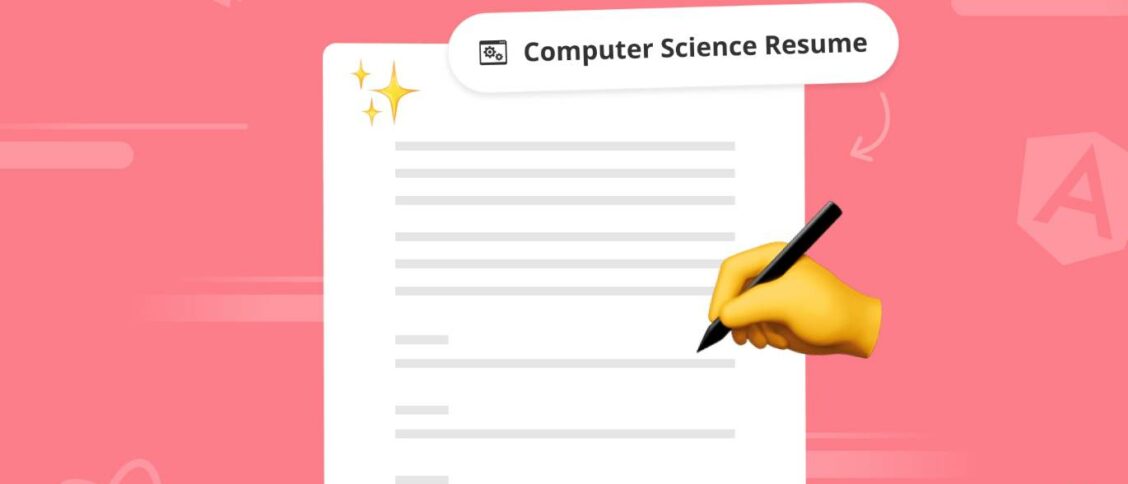A degree in computer science can open many doors. But how do you show that off on a computer science resume?
It’s a highly desirable qualification, and it goes a long way towards attracting potential tech employers in the job market. But to truly separate yourself in a competitive employment environment, you’ll first need to put a quality computer science resume together.
As we walk through the various steps, let’s follow the story of Ella, a recent computer science grad student ready to take the tech industry by storm.
Ella Hyde just finished her studies at the Computer Science Department of NYU Courant Institute of Mathematical Sciences (say that three times fast!). She now needs to craft a resume that will help land her dream job in the tech industry.
Let’s join her as she learns how to write a computer science resume for a position at Microsoft.
Looking to hire the best remote developers? Arc can help you:
⚡️ Get instant candidate matches without searching
⚡️ Identify top applicants from our network of 350,000+
⚡️ Hire 4x faster with vetted candidates (qualified and interview-ready)
Try Arc to hire top developers now →
How to Write a Computer Science Resume
1. Before Writing Your Resume
Before you start writing your resume for computer science, consider a few things in preparation.
First, what do you intend to do with this resume?
For example, do you want to apply for software developer or engineering jobs at a top startup? A strong CS resume can help you with this, but you need to have a clear goal in mind.
Once you have that goal figured out, look at your history and determine your greatest strengths. This will inform the resume format you adopt. You can choose to format it in reverse-chronological order or functionally.
Most resumes use a reverse-chronological framework, which is the one we recommend. In this resume format, you showcase your work experience, educational background, and other time-based sections in reverse-chronological order. For each, start with your last position and company, and work your way back.
For example, Ella worked as a software developer for an established tech company during one of her summer vacations. However, she didn’t like the environment because of how overly structured it could get, so she decided startup jobs would be a better fit than software engineering jobs at an established company. If you have a robust work history like our Ella, then go for the chronological resume format.
On the other hand, functional resumes highlight your abilities and critical skills and how you can use these abilities to be an excellent fit for the company you’re applying to. If you have gaps in your work history, are transitioning to a new career, or have changed jobs very often, a functional resume can help you start with the right foot forward.
After picking the best format, you should always tailor your comp sci resume to each company and vacancy. Go through the job description to identify keywords to use. This shows the company you care and want to become a valuable addition to their particular company.
Lastly, remember to leave plenty of white space throughout the document to make it easier and more pleasant to read for the reviewer. And, in turn, that helps ensure your resume actually gets read!
Read More: Here’s How to Format a Software Developer Resume
2. Contact Details
The first part of your computer science resume is where you place your contact details, which is pretty straightforward.
Start with your first and last name. Below that, you can include a branding statement or your current job title. However, only do so if you feel that it is appropriate for the position and company you’re applying for. After this, you can state your address. This is not a necessity for remote positions, but it is helpful for location-relevant ones. For remote jobs, you may want to mention your time zone here.
Add your mobile number, ensuring you include your country code (you never know where a global company’s HR team might be located!). Record a professional-sounding voicemail greeting in case potential employers need to leave a message.
Following this, add your email address. This, too, should be professional, being some combination of your first and last name. Don’t include a messy email like fancyangelxoxo124@aol.com.
Finally, provide links to relevant social media profiles, portfolios, or professional websites. It’s especially important to include a GitHub link if you have any developer projects there, so that employers can easily see your code and contributions.
Avoid including any sensitive information, such as your birthday or social security number. Doing so might place you at risk of identity theft or other security threats. Similarly, do not state any political or religious affiliations you might have. Not only is this inappropriate, but it places you at risk of falling afoul of reviewers’ conscious or unconscious biases.
Let’s see how Ella approaches her contact details section in the following computer science resume example:
Ella J. Hyde Ambitious Software Engineer, MS in Computer Science +1 (555) 321-9871 hyde.j.ella@gmail.com github.com/ellajhyde/ linkedin.com/in/ellajhyde ellajhydeportfolio.com

Arc is the best place to find great remote jobs. Find great remote jobs at top startups and tech companies. Freelance and full-time remote opportunities are available.
Sign up here
Read More: Avoid These Common Remote Interview Mistakes!
3. Introductory Paragraph/Summary Statement
Your next order of business is to craft an impactful and memorable introductory paragraph. Recruiters spend an average of 7.4 seconds looking at CVs, so this needs to capture their attention. If it doesn’t, then they won’t read the rest.
Your summary statement should be at the top of your CV and should be concise yet comprehensive.
Write all the relevant points in no more than three to five sentences. Additionally, specifically tailor the statement to the job you’re applying for, directly referencing the company and position in question. Include relevant keywords. These should cover your education, skills, professional experience, and similar areas and reflect the software engineering job advertisement’s wording.
Including numbers as evidence of your accomplishments is a particularly effective way to demonstrate your value as an employee. For instance, rather than saying you “improved team efficiency,” specify that you “increased team efficiency by 56%” where possible.
As we can see from Ella’s computer science resume sample, she has a concise and attention-grabbing statement:
Summary Statement
Recent computer science graduate (master’s degree) with one year of experience as an intern at Google where I increased team productivity by 13%. Member of the Association for Women in Computing, with a certification from Harvard in Building Interactive Web Applications For Data Analysis. Keen on building on computer science background and programming experience to become a valuable Microsoft software developer.
Read More: How to Be a Software Engineer (Complete Guide)
4. Work Experience
Once you’ve caught the recruiter’s attention, it’s time to reel them in further with your work experience. This is the core of your computer science resume and needs to highlight the crowning achievements of your career so far.
With each entry, put your job title first. Then, under this, write the organization’s name, where you were based, and the dates of your employment. The month and year alone will do. Following this, you should clearly explain your responsibilities and your achievements.
As with your introductory paragraph, use numbers to add weight to your accomplishments. Finally, put your most recent role at the top, then list each job before that in turn.
Ella’s first entry should give you a good understanding of how to structure this:
Work Experience
Software Engineering Intern
Google, San Francisco, CA
January 2020 – January 2021
- Supported multiple projects covering desktop and web applications, mobile apps, network systems, and operating systems.
- Designed, tested, and maintained software solutions on an ad hoc basis.
- Proposed and implemented strategic productivity measures, which increased team efficiency by 13% in six months.
5. Academic History
Next, you’ll have the opportunity to demonstrate your academic achievements. Recruiters hiring for software developer jobs, data scientist jobs, and other similar roles are keen to see your educational accomplishments.
When writing these out, put your qualification first. Follow this with the name of the educational institution and its location. After that, write the dates you attended, followed by all the relevant pieces of coursework that you undertook.
If you have achieved any Latin honors, then these should be listed at the end. Bear in mind that you should write them in lower case and italics because these are in Latin. You may also want to consider including your GPA, particularly if it’s excellent.
To include your GPA, write it in parenthesis after your major. However, if you have achieved Latin honors, then you should write it directly after this.
To illustrate this, let’s take a look at some resume examples. Firstly, let’s see how candidates should display their master’s and bachelor’s degrees:
Education
Master of Science (MSc) in Computer Science
Courant Institute of Mathematical Sciences, New York University, New York, NY
September 2018 – June 2019
Relevant Coursework: Design & Analysis of Algorithms, Principles of Database Systems, Software Engineering, Computer Architecture, Information Visualization, Programming Languages.
Honors: cum laude (GPA: 3.8)
Bachelor of Science (BSc) in Computer Science
Tandon School of Engineering, New York University, New York, NY
September 2014 – June 2018
Relevant Coursework: Information, Security and Privacy, Computer Networking, Machine Learning, Selected Topics in CS.
If you haven’t yet completed your degree, just include information on when you started and the expected graduation date. For example: “September 2019 – June 2023 (expected graduation date)”.
To add your high school diploma, follow the same structure as detailed above. Here you might also list extracurricular activities if they are relevant to the post you’re applying for. Add this below the other details, and it should look like the following example:
High School Diploma
Lakeside High School, New York, NY
September 2014 – June 2018
Relevant Extracurricular Activities: Member of The Mathematics Honor Society, 2017–2018. Chaired regular meetings, organized guest lectures by researchers, and attended conferences.
6. Skills
The skills section of a computer science resume is vital. You should include a range of keywords here because recruiters will expect candidates to demonstrate certain abilities, including:
- Mathematics
- Artificial intelligence/AI
- Computer and technology knowledge
- Database administration
- Algorithms
- Machine learning/ML
- Best programming languages
- Software development
- Computer hardware engineering
- Data analysis skills
- Data science
- Information systems management
- Technical writing
You shouldn’t list all of these keywords, of course, as you need to be tailoring your resume by including skills keywords that are relevant to the role. You can easily discern which ones to use by carefully reading the job advert.
If you choose, you can also indicate the degree of expertise you possess with each skill. You can achieve this by arranging the skills according to your proficiency. These can range from expert to novice. For example:
Expert (⭐⭐⭐⭐⭐) Computer and technology knowledge
Advanced (⭐⭐⭐⭐) Algorithms
Familiar (⭐⭐⭐) Data analysis
Intermediate (⭐⭐) Technical writing
Beginner (⭐) Software development
Remember, though, that even though this is a computer science resume, you still need to demonstrate soft skills. Abilities such as “teamwork and cooperation,” “excellent organization,” and “good communication” are necessary for all roles, and particularly valuable as a remote software developer.
Read More: Important Hard Skills and Soft Skills to Include in a Software Developer Resume
7. Certifications
For computer science roles, certifications can sometimes be even more valuable than the technical skills you just listed. If you have one of the following, for example, then they should be included in your resume:
- Artificial Intelligence: Implications For Business Strategy (Offered by MIT)
- Machine Learning with TensorFlow on Google Cloud Platform Specialization
- Machine Learning (Offered by Stanford)
- Computer Science for Web Programming (Offered by Harvard)
- Data Analytics Using Python (In Collaboration with GitHub)
- IBM Applied AI Professional Certificate (Offered by IBM)
- Google Data Analytics Professional Certificate
- Building Interactive Web Applications for Data Analysis
Add these by listing the award name, then the awarding organization, followed by the year obtained. Use the computer science resume example snippet below as a guide:
Certifications
- “Building Interactive Web Applications For Data Analysis,” Harvard University, 2020
8. Other CS Resume Sections
You may also benefit from including other sections in your computer science CV if they add value to your application. These may include:
Organization Memberships
If you’re a member of any computer science professional organizations, you should include these here. For instance, you might be a member of the IEEE Computer Society, the Computing Research Association, or the Association for Women in Computing. If so, including these details could help set you apart.
Volunteer Work
If you have done any relevant volunteer work, it can demonstrate additional valuable skills and provide some insight into your character. An example of relevant computer science volunteer work could be Microsoft’s Technology Education and Literacy in Schools program.
(Human) Languages
Employers always appreciate additional languages, especially in a remote-first or hybrid working environment. Make sure to list these here, where applicable.
Hobbies & Interests
Any number of hobbies and interests may help your computer science resume to stand out. For instance, you could include that you code games or manage websites in your spare time.
Computer Science Projects on a Resume
If you have relevant computer science projects, you can add these, if you prefer, especially if you have a more entry-level computer science resume. However, if your resume is quite long, then it might be better to provide a link to the project profile or your work portfolio instead.
You can also explore HireAI to skip the line and:
⚡️ Get instant candidate matches without searching
⚡️ Identify top applicants from our network of 350,000+ with no manual screening
⚡️ Hire 4x faster with vetted candidates (qualified and interview-ready)
Try HireAI and hire top developers now →
Great Computer Science Resume Tips to Remember
1. Establish a clear goal first
It’s vital to establish why you’re creating a resume in the first place. This will determine whether you use a chronological or functional format. Are you making a career switch, or are you re-entering the workforce after a period of absence? Do you have the level of experience required? Ask yourself these types of questions to establish a solid foundation for your resume.
2. Be honest and upfront
Lying or even stretching the truth on your resume is never a good idea. It will only come back to bite you, either during an interview, background check, or post-hiring. Authenticity is critical. Employers will appreciate a candidate who is upfront about specific weaknesses and actively works towards improving more than someone who overstates or makes up their technical skills and abilities.
3. Demonstrate a willingness to learn
Employers value coachable workers who are open to developing new skills and progressing in their careers. Showing an eagerness to learn demonstrates that you are self-motivated to tackle different challenges, grow in your role, and positively contribute to team and company-wide success.
4. Keep your resume as short as possible
A computer science resume should be concise enought while still having everything they need to consider you for the job. Remove any extraneous information. Every sentence and word should be relevant to the position and add value to your application. While the length will ultimately depend on your career to date, recent graduates’ resumes and resumes with no experience generally shouldn’t be longer than a single page.
5. Add your resume to your LinkedIn profile
You should always tailor your resume to each specific job you apply for. However, it’s worth adding a more general one to your LinkedIn profile. This allows prospective employers and headhunters to conveniently download a PDF to look through. Anything that facilitates bringing you to the attention of a potential employer is useful.
6. Write an engaging cover letter
Make sure you include a great computer science cover letter. A cover letter is a powerful tool to use in your quest to land a tech interview. Just be sure it doesn’t repeat everything already mentioned in your resume!
That’s How To Write A Computer Science Resume
We hope we left you with everything you need to know about how to write a resume for computer science jobs! Apply the key points you’ve learned here to help you land your dream role.
If you have any questions about writing a computer science resume, then please leave a comment below. We will reply as soon as we can. Thanks for reading, and good luck with your job hunt!
Read More: How to Write a Software Engineer Resume or How to Write a Web Developer Resume or How to Write an IT Resume
You can also explore HireAI to skip the line and:
⚡️ Get instant candidate matches without searching
⚡️ Identify top applicants from our network of 350,000+ with no manual screening
⚡️ Hire 4x faster with vetted candidates (qualified and interview-ready)








